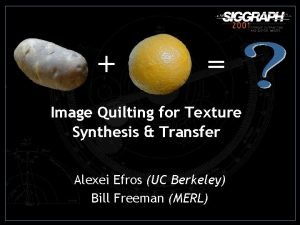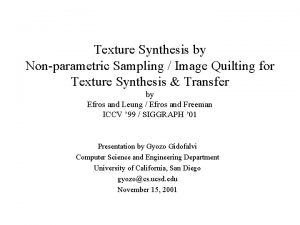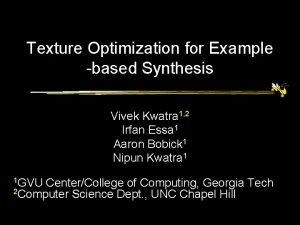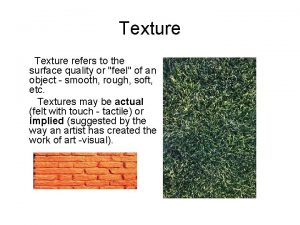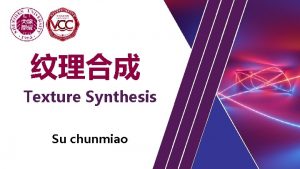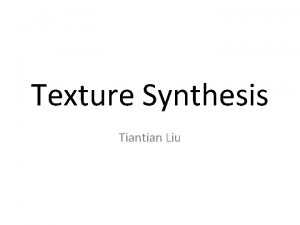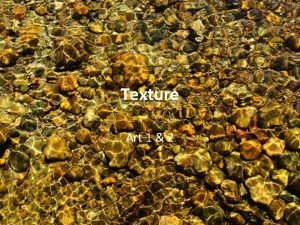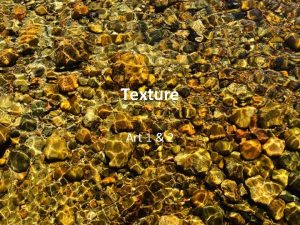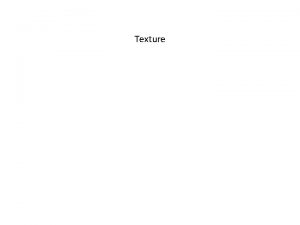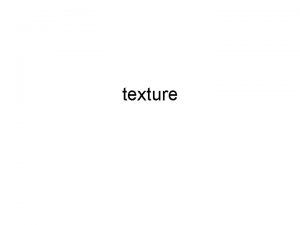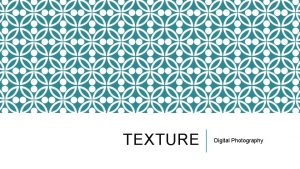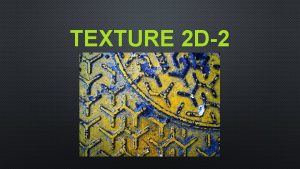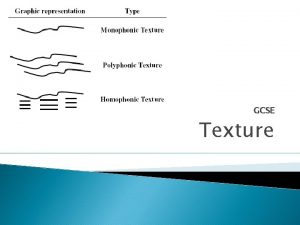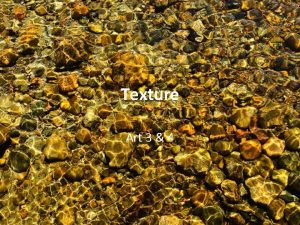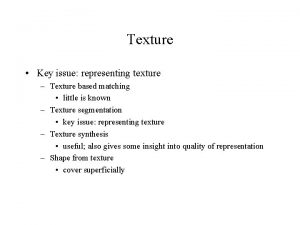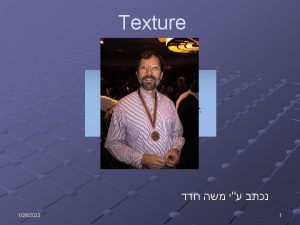Texture Analysis and Synthesis Texture Texture pattern that








![Clustering Textons Image Clustered Textons Texton to Pixel Mapping [Malik et al. ] Clustering Textons Image Clustered Textons Texton to Pixel Mapping [Malik et al. ]](https://slidetodoc.com/presentation_image/2d3aef1ad2c1df0ea4574e01ad2571c5/image-9.jpg)

![Texture Segmentation [Malik et al. ] Texture Segmentation [Malik et al. ]](https://slidetodoc.com/presentation_image/2d3aef1ad2c1df0ea4574e01ad2571c5/image-11.jpg)


- Slides: 13

Texture Analysis and Synthesis

Texture • Texture: pattern that “looks the same” at all locations • May be structured or random [Wei & Levoy]

Applications of Textures • Texture analysis – Detemining statistical properties of textures – Segmentation – Recognition – Shape from texture • Texture synthesis

Oriented Filter Banks Multiresolution Oriented Filter Bank Original Image Steerable Pyramid

Steerable Pyramid Texture Analysis • Pass image through filter bank • Compile histogram of intensities output by each filter • To synthesize new texture: – Start with random noise image – Adjust histograms to match original image – Re-synthesize image from filter outputs

Texture Analysis / Synthesis Original Texture Synthesized Texture Heeger and Bergen

Textons • Elements (“textons”) either identical or come from some statistical distribution • Can analyze in natural images Olhausen & Field

Clustering Textons • Output of bank of n filters can be thought of as vector in n-dimensional space • Can cluster these vectors using k-means [Malik et al. ] • Result: dictionary of most common textures
![Clustering Textons Image Clustered Textons Texton to Pixel Mapping Malik et al Clustering Textons Image Clustered Textons Texton to Pixel Mapping [Malik et al. ]](https://slidetodoc.com/presentation_image/2d3aef1ad2c1df0ea4574e01ad2571c5/image-9.jpg)
Clustering Textons Image Clustered Textons Texton to Pixel Mapping [Malik et al. ]

Using Texture in Segmentation • Compute histogram of how many times each of the k clusters occurs in a neighborhood • Define similarity of histograms hi and hj using c 2 • Different histograms separate regions
![Texture Segmentation Malik et al Texture Segmentation [Malik et al. ]](https://slidetodoc.com/presentation_image/2d3aef1ad2c1df0ea4574e01ad2571c5/image-11.jpg)
Texture Segmentation [Malik et al. ]

Markov Random Fields • Different way of thinking about textures • Premise: probability distribution of a pixel depends on values of neighbors • Probability the same throughout image – Extension of Markov chains

Texture Synthesis Based on MRF • For each pixel in destination: – Take already-synthesized neighbors – Find closest match in original texture – Copy pixel to destination • Efros & Leung 1999, speedup by Wei & Levoy 2000 • Extension to copying whole blocks by Efros & Freeman 2001 [Wei & Levoy]
 Ngoại tâm thu thất chùm đôi
Ngoại tâm thu thất chùm đôi Block nhĩ thất độ 2 mobitz 1
Block nhĩ thất độ 2 mobitz 1 Thể thơ truyền thống
Thể thơ truyền thống Thơ thất ngôn tứ tuyệt đường luật
Thơ thất ngôn tứ tuyệt đường luật Walmart thất bại ở nhật
Walmart thất bại ở nhật Tìm độ lớn thật của tam giác abc
Tìm độ lớn thật của tam giác abc Hãy nói thật ít để làm được nhiều
Hãy nói thật ít để làm được nhiều Tôn thất thuyết là ai
Tôn thất thuyết là ai Gây tê cơ vuông thắt lưng
Gây tê cơ vuông thắt lưng Sau thất bại ở hồ điển triệt
Sau thất bại ở hồ điển triệt Image quilting for texture synthesis and transfer
Image quilting for texture synthesis and transfer Texture synthesis by non-parametric sampling
Texture synthesis by non-parametric sampling Texture optimization for example-based synthesis
Texture optimization for example-based synthesis Texture refers to the way something
Texture refers to the way something










